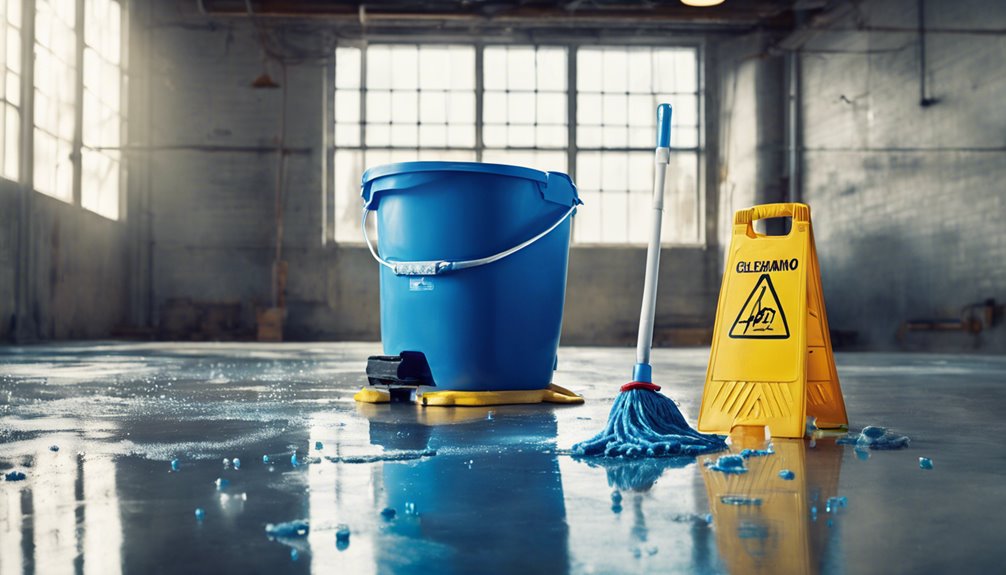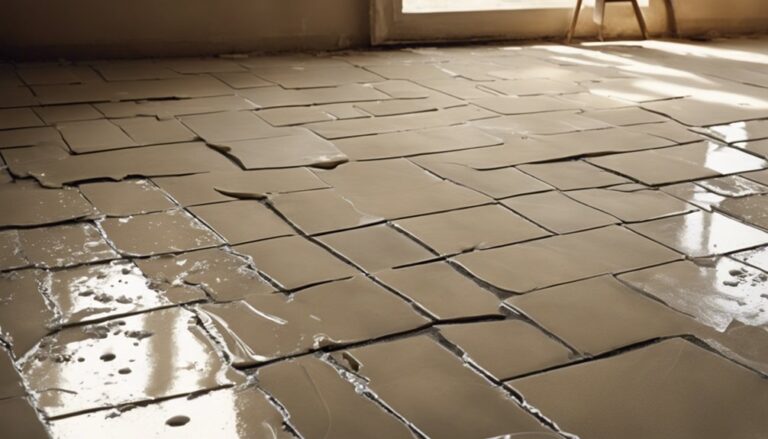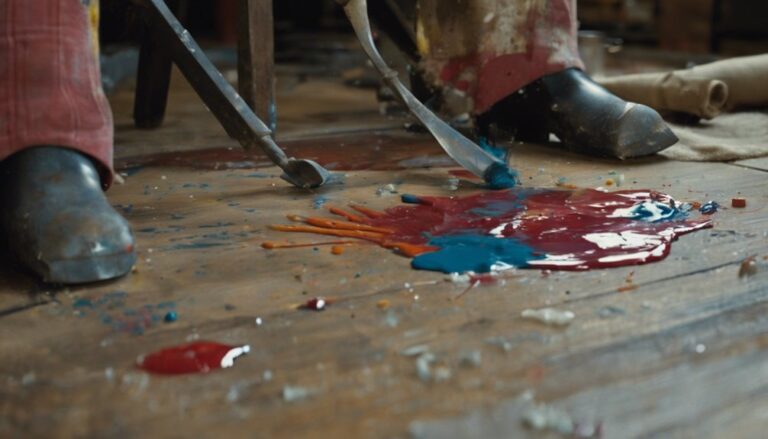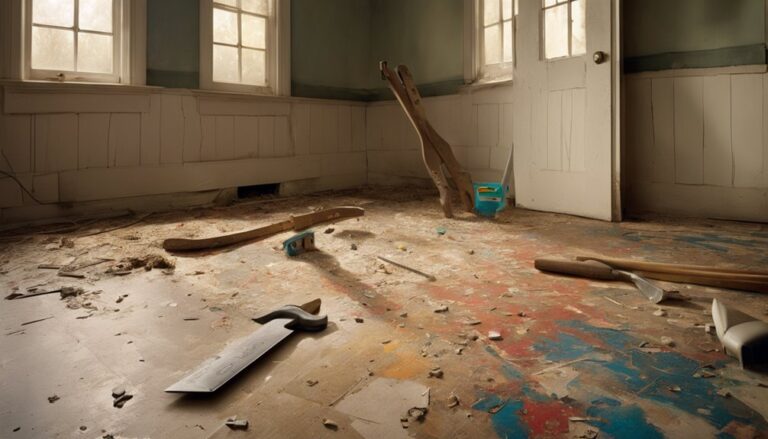To mop concrete floors, start by gathering supplies like a microfiber mop, a bucket with a wringer, and pH-neutral cleaning solution. Clear the area of furniture and debris using a broom or vacuum. Once prepped, mix your cleaning solution and soak the mop, wringing it out so it's damp but not soaking. Mop using figure-eight motions for efficiency, tackling any sticky spots with targeted cleaning. After mopping, rinse the floor if needed and allow it to dry well. Regular maintenance is essential to keep your floors in top condition, and there's more valuable info to explore next.
Gather Your Supplies
Before you plunge into mopping your concrete floors, you'll need to gather a few essential supplies. First, consider your mop selection. A microfiber mop is ideal for concrete, as it effectively traps dirt without scratching the surface. Next, pick up a bucket, preferably one with a wringer to keep the mop damp, not soaking. Don't forget a sturdy broom or vacuum for pre-cleaning—removing loose debris makes mopping easier. You'll also need a suitable cleaning solution; a pH-neutral cleaner works best for concrete. Finally, grab some gloves to protect your hands. With these cleaning tools in hand, you'll be prepared to tackle those floors and enjoy the freedom of a clean, inviting space.
Prepare the Area
With your supplies ready, it's important to prepare the area where you'll be mopping. Start by clearing the space of furniture and any obstacles. This not only makes your job easier but also guarantees cleaning safety by preventing slips and accidents. Next, sweep or vacuum the concrete floor to remove dust and debris; this is essential for effective surface preparation. If there are any sticky spots or stains, pre-treat them with an appropriate cleaner to make mopping easier. Finally, verify the area is well-ventilated. Open windows or doors if possible, as this helps in drying and reduces any strong odors from cleaning products. Taking these steps will set you up for a successful mopping experience!
Choose the Right Mop
When you're ready to mop your concrete floors, selecting the right mop is essential for effective cleaning. You'll want to evaluate different mop types, such as string, flat, or sponge mops, as well as the materials used, since they can impact how well you remove dirt and stains. By choosing wisely, you can guarantee a thorough and efficient cleaning process.
Mop Types Overview
Choosing the right mop for your concrete floors can greatly impact both cleaning efficiency and the floor's longevity. When considering mop types, focus on mop materials and designs that suit your needs. Microfiber mops are excellent for picking up dirt and dust, while sponge mops can hold more liquid, making them ideal for deeper cleans. For a more traditional approach, string mops are durable but may require more effort. Flat mops are easy to maneuver and often come with washable pads. Each design has its strengths, so think about the cleaning tasks you'll tackle most often. By selecting the right combination of materials and designs, you'll enhance your cleaning routine and maintain your concrete floors effectively.
Material Considerations
Selecting the right mop material is essential for effective cleaning of concrete floors. The right choice can enhance your cleaning tools and provide superior surface protection. Consider the following options:
- Microfiber: Excellent for trapping dirt and moisture without scratching.
- Cotton: Good for heavy-duty cleaning, but may leave lint behind.
- Sponge: Ideal for spills and uneven surfaces, but can wear out quickly.
When choosing, think about the specific needs of your concrete floors. For instance, if you're dealing with heavy grime, a cotton mop might be your best bet. However, if you want a gentler touch, microfiber will do wonders. Remember, the right mop not only cleans effectively but also helps preserve your floors for the long run.
Select a Cleaning Solution
When it comes to selecting a cleaning solution for your concrete floors, you've got a couple of options. You can choose between commercial products specifically designed for concrete or whip up a DIY solution using common household items. Consider the level of dirt and stains on your floor to determine which type will work best for your needs.
Types of Cleaning Solutions
The right cleaning solution can make all the difference in maintaining your concrete floors. You want to choose something effective yet safe, especially if you're concerned about the environment. Here are some options to evaluate:
- Eco-friendly options: Look for biodegradable cleaners that won't harm the planet.
- Vinegar and water: A simple mix can tackle light stains and odors while being gentle on surfaces.
- Commercial cleaners: Some are specifically formulated for concrete and can help with tougher stain removal.
When selecting a solution, think about the type of stains you're dealing with and your desire for eco-friendly options. This way, you'll keep your floors looking great while also protecting the environment. Choose wisely, and enjoy your clean, beautiful space!
DIY vs. Store-Bought
Deciding between DIY and store-bought cleaning solutions can greatly impact the effectiveness of mopping your concrete floors. Homemade cleaners, like a simple mixture of vinegar and water, can be cost-effective and eco-friendly options. They're easy to whip up and free from harsh chemicals, giving you peace of mind while cleaning. On the other hand, store-bought solutions may offer convenience and specific formulations designed for concrete, ensuring you get the best results without the guesswork. Consider your cleaning needs and preferences. If you enjoy crafting your own solutions and want to minimize environmental impact, go for homemade cleaners. If you prefer a quick grab-and-go option, a store-bought cleaner might suit you better. Ultimately, it's about what works best for your lifestyle.
Start Mopping Techniques
Begin by gathering your materials: a mop suitable for concrete floors, a bucket, and a cleaning solution designed for hard surfaces. Once you've got everything ready, it's time to immerse yourself in mopping techniques. Start by soaking the mop in your cleaning solution, then wring it out so it's damp, not dripping.
Consider these effective patterns for best results:
- Figure-Eight Motions: This helps cover more ground.
- S-shaped Strokes: Great for tackling edges and corners.
- Straight Lines: Ideal for maintaining consistency.
Work in sections, moving methodically across the floor. Don't forget to overlap your strokes to avoid missed spots. Enjoy the freedom of a clean space as you make your way across the surface!
Rinse the Floor
Once you've finished mopping the floor, rinsing it is crucial to remove any remaining cleaning solution and dirt. Start by filling a bucket with clean water, ideally warm, as it helps dissolve residues effectively. Use a mop or soft cloth to apply rinse techniques, guaranteeing you've covered every inch of the surface.
Here's a quick reference table for your rinse process:
| Step | Action | Water Temperature |
|---|---|---|
| 1 | Fill bucket | Warm |
| 2 | Dip mop/cloth | Warm |
| 3 | Wipe the surface | Warm |
| 4 | Change water | As needed |
| 5 | Final rinse | Cool for finish |
Following these steps will guarantee your concrete floor is clean and free from residues, providing a fresh, inviting space.
Drying the Concrete
Drying your concrete floor properly is essential for maintaining its appearance and longevity. Using the right drying techniques can make all the difference in how your floor looks over time.
- Consider air circulation to speed up drying.
- Use a fan or dehumidifier for ideal results.
- Avoid walking on the surface until it's fully dry.
The drying times can vary based on the humidity and temperature in your space. Typically, allowing at least 24 to 48 hours for drying is wise. If you're in a humid area, you might need to extend that time. Keep an eye on the surface; it should feel dry to the touch. This careful attention guarantees your concrete remains stunning and durable for years to come.
Regular Maintenance Tips
Regular maintenance of your concrete floors can greatly extend their life and keep them looking their best. Implementing preventive measures and establishing a cleaning schedule is essential. Here's a quick guide:
| Task | Frequency |
|---|---|
| Sweep or Vacuum | Daily |
| Damp Mop | Weekly |
| Deep Clean | Monthly |
| Sealant Application | Every 1-3 years |
Frequently Asked Questions
Can I Use a Steam Mop on Concrete Floors?
You can definitely use a steam mop on concrete floors, but it's important to take into account its effectiveness for your specific needs. Steam mops can help with deep cleaning and sanitizing, making them a good choice for maintaining your concrete surfaces. Just make sure you're using the right attachments and settings to avoid damage. Regular maintenance with a steam mop can keep your floors looking fresh while giving you the freedom to clean effortlessly.
How Often Should I Mop My Concrete Floors?
When it comes to cleaning frequency, think of your concrete floors as a canvas that needs regular attention. Ideally, you should mop them weekly, especially in high-traffic areas. For maintenance tips, consider a bi-monthly deep clean to keep grime at bay. If you've pets or kids, you might need to adjust your schedule. Staying consistent not only preserves the look but also enhances the longevity of your floors, giving you the freedom to enjoy your space.
Are There Any Eco-Friendly Cleaning Solutions for Concrete?
Yes, there are plenty of eco-friendly cleaning solutions for concrete. You can easily make natural cleaners at home using ingredients like vinegar, baking soda, and essential oils. For a simple homemade solution, mix equal parts vinegar and water in a spray bottle. This not only cleans effectively but also leaves your floors fresh. Just remember to test any solution in a small area first to verify your concrete responds well. Enjoy a cleaner space!
What Should I Do About Stubborn Stains?
When tackling stubborn stains, you'll want to focus on effective stain removal techniques. Start by identifying the stain type; greasy stains might need a degreaser, while rust may require a mixture of vinegar and baking soda. Apply your chosen solution and let it sit for a few minutes. Then, scrub gently with a stiff brush. Rinse thoroughly, and repeat if necessary. This methodical approach can restore your concrete's appearance and give you that freedom from unsightly marks.
Can I Use Vinegar to Clean Concrete Floors?
Yes, you can use vinegar to clean concrete floors! Vinegar's benefits include its natural acidity, which helps break down grime and stains effectively. For a practical cleaning method, mix equal parts vinegar and water in a bucket. Use a mop or cloth to apply the solution, allowing it to sit for a few minutes before rinsing with clean water. This method not only cleans but also leaves your concrete looking fresh and revitalized.




